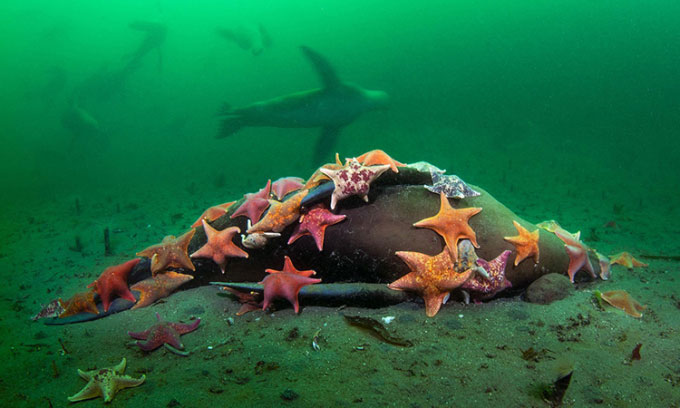Photographer captured an impressive photo: Dozens of starfish gather to eat sea lions
Wildlife photographer David Slater took an impressive photo in the shallow waters of Monterey Bay, California, Live Science reported on June 22. The photo won first prize in the "Sea Creatures" category at the California Institute of Science's Big Picture competition.

Dead sea lions are surrounded by dozens of colorful bat starfish.
The dead sea lion and its companion swimming behind are most likely the California sea lion (Zalophus californianus) or the Steller sea lion (Eumetopias jubatus), based on the geographical ranges of these two species. The starfish in the photo are all bat starfish (Patiria miniata) - a scavenger with rich colors. They play an important role in "recycling" the sea lion carcass into energy and nutrients, returning it to the marine food web.
Experts are not sure why the sea lion in the picture lost its life. It is possible that it died of natural causes or was killed by man-made factors, such as collisions with boats, ingestion of plastic or entanglement in fishing gear. However, California sea lion populations are actually increasing in size and are classified as "least concern" on the International Union for Conservation of Nature (IUCN) Red List.
The name "bat starfish" comes from the membranes that grow between their arms, which look like bat wings. This animal usually has 5 arms, but can also have up to 9 arms. Bat starfish typically grow to a width of 20 centimeters, according to the Monterey Bay Aquarium. They are noted with many colors but the most common are red, orange, yellow, brown, green, purple.
Bat sea stars have light-sensing "eye spots" at the end of each arm and olfactory cells under the arms that allow them to "taste" chemicals left behind by small invertebrates or carcasses in the water. When they find food, they will push one of their stomachs out of their mouths and secrete digestive enzymes to break down the food before eating it.
Starfish also have symbiotic small worms that live in grooves on the underside of their bodies and feed on debris left behind by their hosts. A bat starfish can hold up to 20 worms. So in the picture there may be more than 100 worms that are also busy eating sea lion carcasses.
As scavengers, bat starfish and symbiotic worms play an important role in ocean ecosystems because they help recycle nutrients and energy from the top of the food chain back to the bottom. "When the bat starfish is full, any other creature large or small can gain energy and shelter from what's left over for years to come," the Big Picture contest organizer wrote.
- The life of a crane
- Video: Watching 'stars' collide on the seabed
- Impressive space photo 2014
- Starfish links lacking in visual evolution?
- Learn about the colorful starfish world
- Quickly evolutionary unimaginable starfish
- Admire the natural photos won the World Press Photo Award 2016
- Strange: Starfish exploded massively in America
- 24 hours a day shows through a photo
- Kung Fu 's eye training
- Beautiful photo: Lost in the world of insects
- Appearing 'Zombie starfish' in the ocean warns for an immeasurable danger
 Surprised: Fish that live in the dark ocean still see colors
Surprised: Fish that live in the dark ocean still see colors Japan suddenly caught the creature that caused the earthquake in the legend
Japan suddenly caught the creature that caused the earthquake in the legend A series of gray whale carcasses washed ashore on California's coast
A series of gray whale carcasses washed ashore on California's coast Compare the size of shark species in the world
Compare the size of shark species in the world